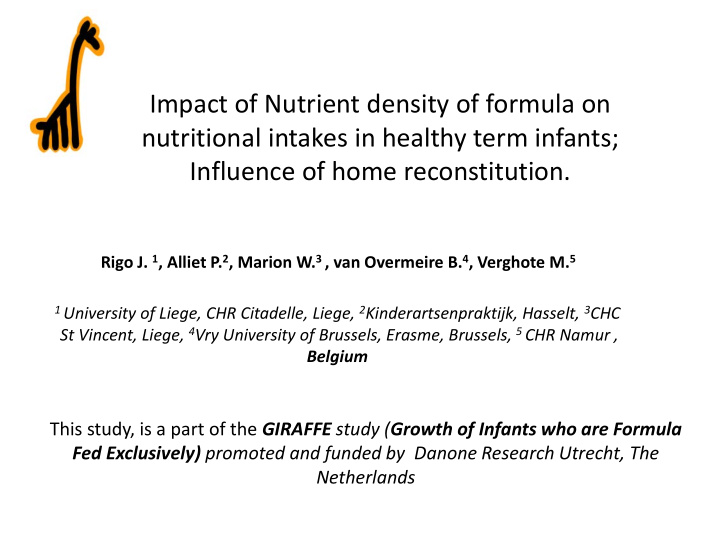



Impact of Nutrient density of formula on nutritional intakes in healthy term infants; Influence of home reconstitution. Rigo J. 1 , Alliet P. 2 , Marion W. 3 , van Overmeire B. 4 , Verghote M. 5 1 University of Liege, CHR Citadelle, Liege, 2 Kinderartsenpraktijk, Hasselt, 3 CHC St Vincent, Liege, 4 Vry University of Brussels, Erasme, Brussels, 5 CHR Namur , Belgium This study, is a part of the GIRAFFE study ( Growth of Infants who are Formula Fed Exclusively) promoted and funded by Danone Research Utrecht, The Netherlands
Study objective The study is a part of a prospective, double-blind RCT investigating the nutritional efficacy and suitability of hypo-allergenic formula with lowered protein content until 16 weeks of life in healthy term infants. • Control product: 2.27 g protein /100 kcal ( 1.50 g & 66 kcal/dL ) • Investigational product I: 2.0 g protein /100 kcal ( 1.32 g & 66 kcal/dL ) • Investigational product II: 1.8 g protein /100 kcal ( 1.19 g & 66 kcal/dL ) • • Primary study outcome of the GIRAFFE study is a weight gain equivalent to the WHO reference values. • Primary outcome of the present study is the influence of home reconstitution on nutritional intakes and growth 2
Study design Diary : adverse events, medication, concomitant food Measurements of weight, length, head circumference (arm circumference at 4, 12, 16 & 52 weeks) Q Q Q Q Healthy, full-term 3 days aged between Bottle Bottle Blood sample food intake 0 and 14 days analysis analysis exclusively formula fed Body composition Investigational product with a protein content of 1.8 g/100 kcal n=52 N=156 Investigational product with a protein content of 2.0 g/100 kcal n=52 Control product with a protein content of 2.27 g/100 kcal n=52 Age: baseline 4 weeks 8 weeks 12 weeks 16 weeks 52 weeks Study entry & randomisation Q = Questionnaire : 7 days formula intake , GI tolerance
Material and Methods We calculated: • Protein content of formulas: N*6.25 as well as the formula density: Fat content/Fat labeled • Protein and energy intakes at 4 and 12 wks from chemical and labeled values considering the mean volume intake during the corresponding 7 days record. • Weight gain between 4 and 12 wks in g, g/d, g/kg*d We compared: • Protein & energy intakes estimated from chemical analysis to that from labeled values. We evaluated: • The relationship between formula intake and the formula density. • The influence of formula density on weight gain between 4 and 12 wks.
Results • 207 subjects were included in the GIRAFFE study. Of those, 162 subjects completed the intervention period of 16 weeks (PP). • In all, 333 bottles were collected and analyzed in our laboratory. In 6 bottled, the results of the fat and the nitrogen contents were discordant, and the results were excluded from the final analysis. • 7 days formula intakes reported as <100 or >220 ml/kg body weight*day were considered as out of ranges (n=29) and were excluded from the final analysis (n=298). Paired data at 4 and 12 wks were finally obtained in 129 infants.
Protein and energy content of the home prepared Bottles n=258 Formula density range (Chem fat/label fat): (0.87 – 1.14 ) at 4wks and (0.86 - 1.15) at 12 wks
Formula and nutrient intakes at 4 and 12 wks of age Intakes (/kg*d) 4 weeks 12 weeks Paired t test N=129 N=129 Volume (ml) 168,7 ± 23,0 137,4 ± 19,1 p<0.0001 Protein -Label 2,25 ± 0,40 1,83 ± 0,32 p<0.0001 2,35 ± 0,46 § 1,94 ± 0,36 § -Chemical p<0.0001 Fat -Label 5,91 ± 0,81 4,87 ± 0,67 p<0.0001 4,81 ± 0,67 $ -Chemical 5,91 ± 0,88 p<0.0001 Energy -Label 111,4 ± 15,2 90,7 ±12,6 p<0.0001 91,9 ± 12,7 $ -Chemical 111,4 ± 16,6 p<0.0001 Density * -label 1.00 1.00 1,042 ± 0,080 1,064 ± 0,087 p=0.001 -Chemical (Prot.) 1,002 ± 0,068 £ 1,016 ± 0,062 $ p=0,014 -Chemical (Fat) (0.87 – 1.14) (0.86 - 1.15) Range $ p<0.05; £ p<0.005; § p<0.0001 * The difference between the calculated fat density and protein density could be the result of a laboratory slight overestimation of the nitrogen content or to the use of an inadequate conversion factor: Prot= N*6.25
Relationship between volume intakes and the formula density Vol intake (ml/kg*d)= -0.789 * Formula density + 233.2; r=0.20; p= 0.00057; n=298
Weight gain during the Study Weight gain Girls Boys Total 4 to 12 wks n=65 n=64 n=129 1.80±0.40 c Kg/study 1.59±0.37 1,68±0,38 31.5±7.0 c g/d 27.8±5.1 29,6±6,4 4.34±0,79 c g/kg*d 3.96±0.64 4,15±0,74 1.46±0,19 c Prot g/dl 1.37±0.18 1.39±0.18 4,323±0,426 c BW at 4 wks (g) 4,073±0,492 4.197±0,475
Body weight Z-Scores compared to WHO Values
Relationship between weight gain and E intake (F=24.2) is improve when and F density is included in the relation (F=30.3) WG= WG (g/kg*d=O.029*E intake (labelled)+ 2.43* F density – 1.236; n=129;r=0.44; p E int<O.OOOOO1; p F density=0.026
In conclusion Our study suggests: • The reconstitution procedure at home significantly influences the nutrient density of the studied formulas. • Density of powder formula is an additional factor to volume intake to be considered in nutritional studies. It could also influence the sample size evaluation. • Formula intakes at 4 and 12 wks are inversely related to the formula density. • Weight gain is related to energy intakes but also to formula density that needs to be considered as an additional factor. . Reconstitution procedure needs to be take into account in the interpretation of the results in nutritional studies using powder formula in healthy term infants.
Recommend
More recommend